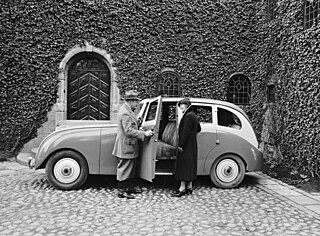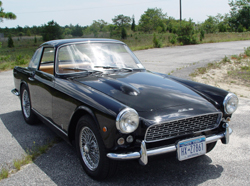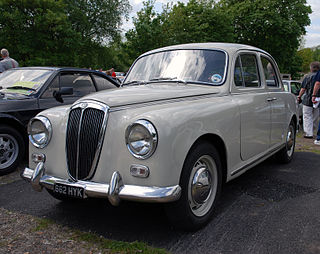Related Research Articles

Giovanni Michelotti was one of the most prolific designers of sports cars in the 20th century. His notable contributions were for Ferrari, Lancia, Maserati and Triumph marques. He was also associated with truck designs for Leyland Motors, and with designs for British Leyland after the merger of Leyland and BMC.

Carrozzeria Vignale was an Italian automobile coachbuilder. Carrozzeria Alfredo Vignale was established in 1948 at Via Cigliano, Turin by Alfredo Vignale (1913–69). After its founder's death in 1969, the studio ceased operation, but ownership of the name passed to Ford, which has continued to use the name sporadically to the present day.

Carrozzeria Ghia SpA is an Italian automobile design and coachbuilding firm, established by Giacinto Ghia and Gariglio as Carrozzeria Ghia & Gariglio. The headquarters is located at Corso Guglielmo Marconi, 4, Turin, Italy.

Ferrari America is a series of top-end Ferrari models built in the 1950s and 1960s. They were large grand touring cars with the largest V12 engines and often had custom bodywork. All America models used a live axle in the rear, were front-engined, and had worm and sector steering.

The Ferrari 250 is a series of sports cars and grand tourers built by Ferrari from 1952 to 1964. The company's most successful early line, the 250 series includes many variants designed for road use or sports car racing. 250 series cars are characterized by their use of a 3.0 L (2,953 cc) Colombo V12 engine designed by Gioacchino Colombo. They were replaced by the 275 and 330 series cars.

The Ferrari 212 Inter replaced Ferrari's successful 166 and 195 Inter grand tourers in 1951. Unveiled at the Brussels Motor Show that year, the 212 was an evolution of the 166 — a sports car for the road that could also win international races. In 1951, two 212 Inters, both Vignale coupés, driven by Taruffi/Chinetti and Ascari/Villoresi, scored 1–2 victory at Carrera Panamericana in Mexico.

The Volvo Venus Bilo was a concept car, which was revealed by Volvo Cars sometime in 1933. It was a streamlined design with rear hinged doors and conventional doors in the side to access the engine bay. It was designed to have one such great loading capacity.

Maserati A6 were a series of grand tourers, racing sports cars and single seaters made by Maserati of Italy between 1947 and 1956. They were named for Alfieri Maserati and for their straight-six engine.

The Ferrari 250 S was a sports racing car produced by Ferrari in 1952. It was the first in the long lineage of Ferrari 250 road and race cars powered by a ubiquitous 3.0-litre Colombo V12 engine. In 1952 the 250 S won the Mille Miglia and 12 Hours of Pescara. At the Le Mans, the same year, it clocked the fastest race lap time. Only a single example was produced.

The Ferrari 225 S was a sports racing car produced by Ferrari in 1952. It was an evolution over the preceding Ferrari 212 Export with important engine upgrades that greatly improved power output. The model was extensively used in competition, winning many international races. The most important include 1952 Monaco Grand Prix for sports cars, Portuguese Grand Prix, Coppa d'Oro di Sicilia, Coppa della Toscana, Coppa d'Oro delle Dolomiti and many others. It was the final Colombo V12 engine iteration before the 250-family stretched it to 3.0-litres capacity.

The Triumph Italia 2000 Coupé was built between 1959 and 1962, during which time 330 cars were produced. Designed by Giovanni Michelotti, the TR3 chassis and mechanical components were supplied by the Triumph Motor Company in the United Kingdom, and built by Alfredo Vignale in Turin, Italy.

The Fiat 8V is a V8-engined sports car produced by the Italian car manufacturer Fiat from 1952 to 1954. The car was introduced at the 1952 Geneva Motor Show. The Fiat 8V got its name because at the time of its making, Fiat believed Ford had a copyright on "V8". With 114 made, the 8V wasn't a commercial success, but did well in racing. Apart from the differential the car did not share any parts with the other Fiats. The 8V was developed by Dante Giacosa and the stylist Luigi Rapi. The engine was a V8 originally designed for a luxury sedan, but that project was stopped.

The Lancia Appia is a passenger car introduced in 1953 by Italian car manufacturer Lancia as a replacement for the Ardea, and which remained in production for ten years. The Appia was the last in a long line of Lancia production cars dating back to the Lancia Lambda to use sliding pillar front suspension. All three series produced had a 1089cc Lancia V4 engine.

The Ferrari 212 Export was a sports racing car produced by Ferrari in 1951–1952. The 212 Exports won Tour de France automobile, Giro di Sicilia, Coppa della Toscana, 10 Hours of Messina and other motor races throughout its career. It was meant to be a sports car available for oversea markets.
The Turin Motor Show was an auto show held annually in Turin, Italy. The first official show took place between 21 and 24 April 1900, at the Castle of Valentino, becoming a permanent fixture in Turin from 1938 having shared it with Milan and Rome until that time. From 1972, the show was held biannually and in 1984, it moved into Fiat's shuttered Lingotto factory.

Polestar is a Swedish automotive brand that was established as a new, standalone premium electric vehicle manufacturer in 2017. Founded by Volvo Cars and Geely Holding, Polestar enjoys specific technological and engineering synergies with Volvo Cars and benefits from significant economies of scale as a result. Polestar is headquartered in Torslanda outside Gothenburg, Sweden and its vehicles are currently available and on the road in markets across Europe, North America, China and the Asia Pacific. Polestar cars are currently manufactured in two facilities in China, with additional future manufacturing planned in the USA.
Virginio Vairo is an Italian automobile designer who has collaborated with Carrozzeria Vignale.

The Aston Martin Lagonda Vignale is a five-seater concept car built by Ghia for Lagonda. It was designed by Moray Callum at Ghia and unveiled in 1993 at the Geneva Motor Show alongside the Aston Martin DB7, designed by Moray's older brother, Ian Callum. Built to gauge interest for a 4-door Aston Martin model, the concept was well received, but never went into production as Ford decided that the Lagonda brand would be too expensive to revive due to its relative obscurity outside of the U.K. Interior Design by David Wilkie: Colour and materials by Sally Ericson.

The Ferrari 250 MM was a sports racing car produced by Ferrari in 1953. After the initial racing successes of the 3.0-litre Colombo V12 engine, introduced in the 250 S one-off, Ferrari produced a serial racing model. It is best recognisable for the distinctive closed berlinetta bodywork by Pinin Farina. The "MM" in its name stood for the Mille Miglia race.

The Cunningham C-3 is a sports car, designed, developed and produced by American Briggs Cunningham in 1952.
References
- ↑ "Volvo concept cars – part of a conscious strategy". media.volvocars.com. 28 January 2004. Retrieved 12 November 2020.
- ↑ "Volvo PV444 Elisabeth I Concept (1953)". oldconceptcars.com. 1 May 2017. Archived from the original on 1 May 2017. Retrieved 12 November 2020.
- ↑ "Volvo Elisabeth I". coachbuild.com. 2 October 2020. Retrieved 2 October 2020.